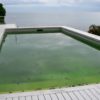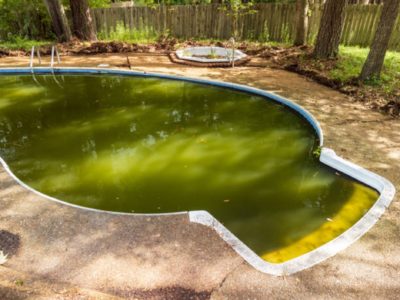How to Prevent and Treat Mustard Algae in Your Pool
Just when you’re above to take a dive into your backyard swimming pool, you see something mucky. Something vile. Ugh! It’s mustard algae, and all your desires to swim your heart out go down the drain! But don’t worry, mustard algae in the pool can be easily treated and prevented. We’re here to help you with just that.

Although not as slimy as green algae, mustard algae infestation can still be a problem. In an ideal world where mustard algae isn’t a problem, it’s still a heinous sight to look at, and we don’t wish it upon anyone!
Mustard algae can easily be mistaken as dirt, sand, or pollen. This is the reason why many people won’t believe that mustard algae thrive in their backyard swimming pools in the first place. Indeed, the devil’s incarnate!
What is mustard algae?
Mustard algae, also known as yellow algae and brown algae, is a chlorine-resistant type of green algae that uncannily resembles dirt or sand on the pool’s bottom or sides. It includes chemicals that function as a defense mechanism against sanitizer oxidation attempts, allowing it to survive even in heavily chlorinated environments.
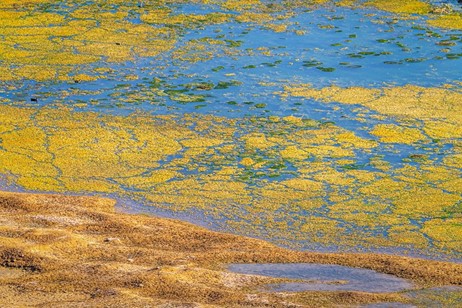
What does mustard algae look like?
Mustard algae is yellowish-green or brown in color. Unlike green algae, it’s not that sludgy. You’ll find it adhering to pool walls as well as other pool objects such as pool equipment, toys, and even bathing suits.
Although it is more prevalent in warmer areas, mustard algae may thrive in any pool. Because it is chlorine resistant, mustard algae can be difficult to remove after it has entrenched itself in your pool.
Mustard algae, unlike green algae, will stick to the pool’s sides or bottom rather than floating. It can also be found in the shady, concealed region of your swimming pool, such as ladder rungs, under lights, and in the pool filter.
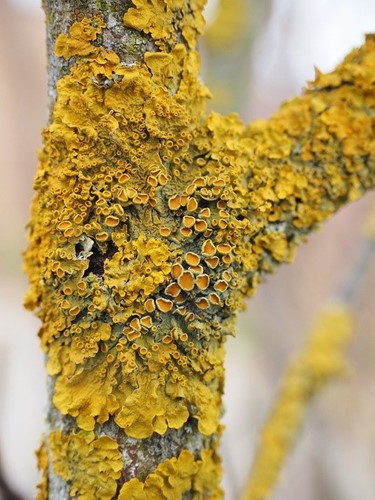
Is mustard algae in the pool dangerous?
Besides being a dreadful sight to look at, is mustard algae in the pool dangerous to your health? The short answer to this is ‘no.’
While mustard algae is not toxic to humans, an excess can attract pathogenic bacteria such as E. coli. Furthermore, mustard algae can cloud your swimming pool water. Because mustard algae is resistant to chlorine, it can be difficult to eradicate after they have entered your pool.
What causes mustard algae to grow in a swimming pool?
There are several sources of that yucky mustard algae in your pool. The algae spores first reach your swimming pool through the weather (such as wind or rain) or through contaminated swimwear or equipment. Algae can bloom fast depending on where you reside and your specific environment. The following factors influence the pace of an algal bloom:
- There have been a lot of pleasant, bright days.
- High amounts of nitrates or carbon dioxide in your pool.
- Inadequately balanced pool water.
- Not adequately disinfecting or filtration your pool.
- Having forgotten about circulation.
Can I prevent mustard algae from infesting my swimming pool?
Yes, mustard algae can very well be prevented if you take preventative measures on time. You must strictly adhere to your swimming pool maintenance and take out some time out of your busy week to clean your swimming pool once every week.
Here’s what you can do to prevent mustard algae from establishing its military bases inside your swimming pool.
- Perform regular water tests. You need to keep your pH and alkalinity levels in check. Your swimming pool water must not have a chemical pH that allows for mustard algae to thrive. You can use pool water test strips or liquid test kits to test your pool water’s pH. Both of these are readily available on the market.
- Let your swimming pool filter and swimming pool pump function for at 12 least hours a day. This helps with the water circulation and counters the growth of mustard algae in the pool.
- Skim away any debris or leaves that you see on the surface of your swimming pool.
- Regularly vacuum your swimming pool.
- Regularly brush the walls, sides, and the ladder of your swimming pool.
- Make use of a powerful pool sanitizer to combat mustard algae growth.
- Make sure the chlorine levels inside your swimming pool are appropriate. Again, you can do this using swimming pool water test strips and liquid test kits.
- Shock your pool once a week.
- Regularly disinfect the accessories you use in your pool.
- Use an algaecide.
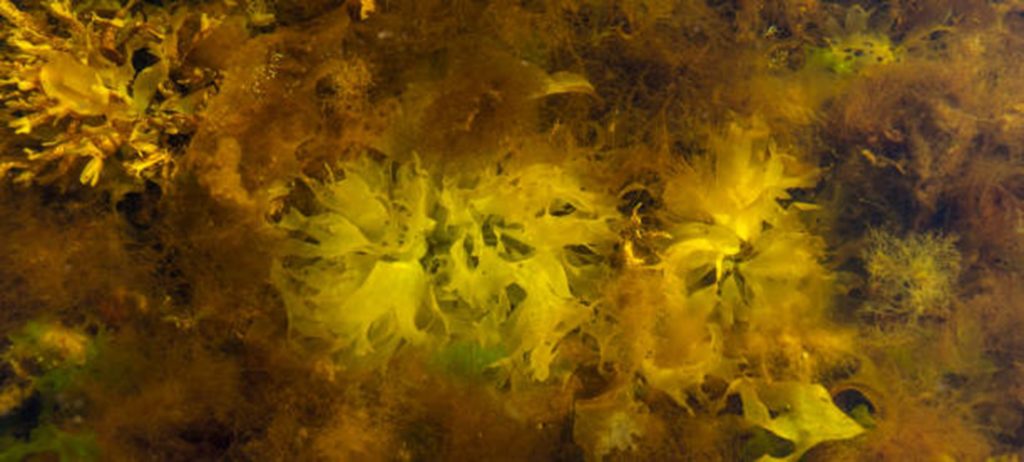
How to get rid of mustard algae in a pool?
If you were unable to prevent mustard algae from inhibiting your pool, don’t be in distress; you can always get rid of mustard algae!
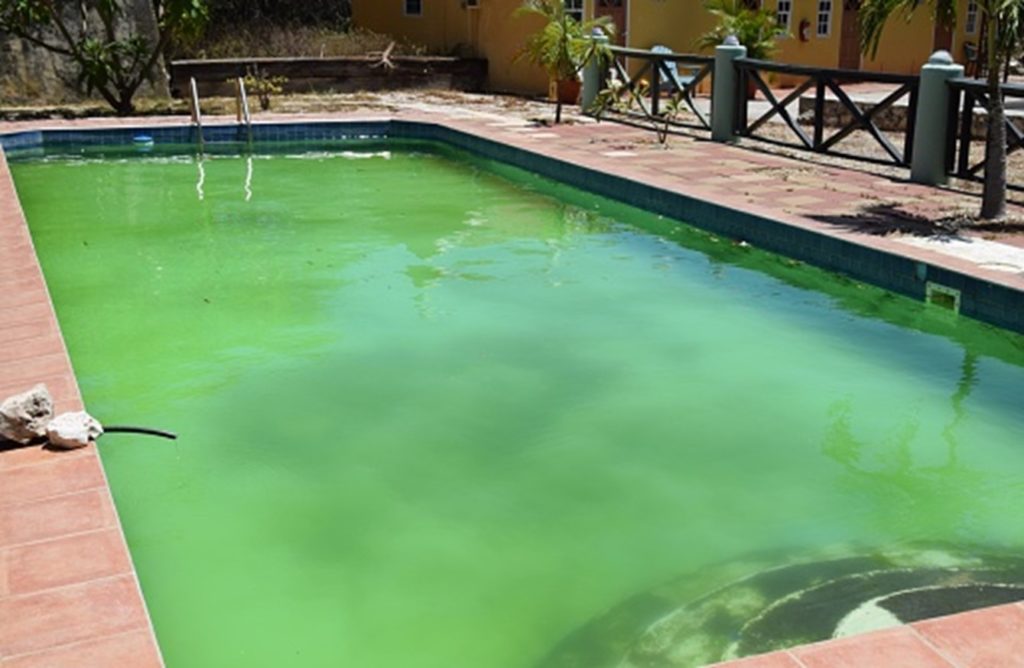
1. Empty your swimming pool
You’ve decided on getting rid of mustard algae – great! The first thing you need to do is empty your swimming pool. Remove everything from your swimming except for the cleaning equipment. Remove any toys, accessories, and any other equipment.
The cleaning equipment should not be removed as you’ll be later sanitizing them through a pool shock. When you’ve removed all the items, clean the items with chlorine or chlorine-based cleaners. You also need to wash your swimming suits and other swimming gear with chlorine.
2. Brush, Brush, Brush
Now, brush the walls, sides, and floor of your swimming pool. Make sure you use a brush with stiff bristles while you’re at it. This helps in removing stubborn mustard algae that just won’t budge. Once you’re done with brushing, vacuum out the waste.
3. Balancing pH
Balancing the pH of your swimming pool is the most crucial aspect when it comes to getting rid of mustard algae in the pool. You can prevent mustard algae growth by never giving them living conditions to thrive in the first place.
When you’re in the process of eliminating mustard algae in your pool, balance your pH and alkalinity levels. An ideal pH for swimming pool water is between 7.2 and 7.4. In contrast, the perfect alkalinity levels lie in the range of 60 and 120 ppm.
4. Time to Shock!
Once you’re done with all that, now’s the time to take a plunge in a more significant step – shocking your swimming pool. For shocking a pool with mustard algae, more substantial amounts of chlorine are required. Use twice or thrice the amount of chlorine you’d usually use to shock your pool.
While you’re at it, brush off the mustard algae aggressively as if your life depends on it. This helps mitigate mustard algae that might be playing a game of hide and seek with you. You might also need to brush your cleaning equipment to remove every trace of mustard algae.
5. Run the pump
Like regular shocks, you need to run the swimming pool pump and let it run for about 24 hours or until the water has completely cleared and there’s no sign of mustard algae. If there’s still some amount of algae, you’ll need to re-shock your swimming pool to get rid of mustard algae.
6. Time for vacuum
Once your pool water has cleared after the shock, it’s time to use a pool vacuum. This is just an additional final step to ensure that every trace of mustard algae has been wiped from existence.
7. Using an algaecide
Now’s the time to take a proactive approach to prevent algae growth in the future – use an algaecide to treat your pool water. This ensures that the pesky mustard algae isn’t anywhere near your swimming pool any time soon.
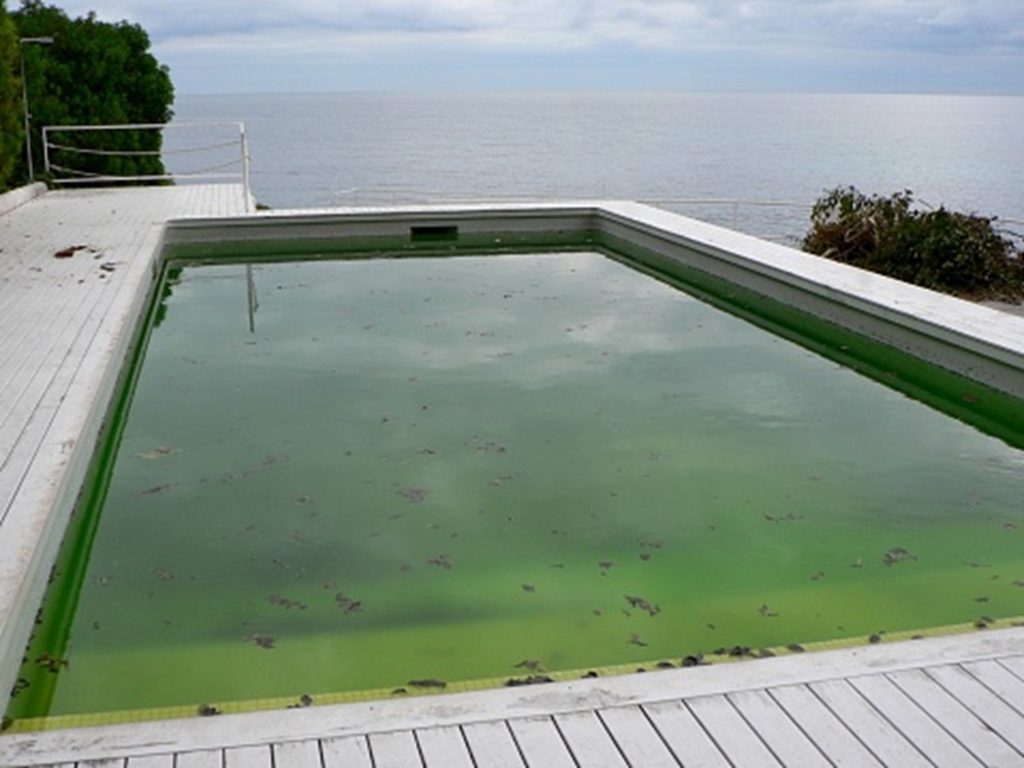
Once you’re done with all that, now’s the time to put back the items you took out from the swimming pool. Make sure they have been thoroughly cleaned with chlorine, or all your efforts would have been for nothing.
Things to do after the removal of mustard algae
Have you gotten rid of mustard algae in your swimming pool? Good to know. Here’s what you can do now to prevent it from coming back.
- Adjust the chlorine, san alkalinity, and pH levels back to optimum levels.
- Make sure you run your pool filter and water filter for more than 12 hours a day.
- Regularly brush and clean your swimming pool. Pay close attention to flecks that might be coming off as dust and debris.
- Put some algaecide inside your pool.
- Use a vacuum cleaner regularly to suck the trash out.

Bottom Line
Mustard algae in a swimming pool can be an unpleasant sight, but it’s very much possible to prevent and get rid of it. However, not dangerous to swim with; mustard algae does cloud the pool water and contributes to a hazy swimming vision if you happen to swim in a pool with mustard algae.
Mustard algae can veil itself as usual dirt, so you have to beware of that. Even though getting rid of mustard algae is relatively easy, you can hire others to do it if you don’t want to do it yourself. Yes, there are professionals available to clean your pool for you!
For now, this is it. We wish you luck in getting mustard algae out of your pool – you’re going to need it!
FAQs
Can you swim in a swimming pool with mustard algae?
Yes, you can. Mustard algae is a swimming pool produced mainly by external causes, and may be difficult to cure since it is chlorine resistant. If left untreated, mustard algae in a swimming pool may obscure the water and create an environment that encourages the growth of dangerous germs.
How did I get mustard algae?
A number of different reasons cause mustard algae. Algae spores reach pools through a variety of channels, including contaminated equipment or swimsuits, rain, and wind. Poor pool maintenance, such as a lack of circulation, cleanliness, and filtration, is another source of mustard algae.
What is the best treatment for mustard algae?
While liquid and granular chlorine have been shown to be efficient sanitizers, utilizing an algaecide formulated particularly to combat yellow algae is the most effective approach to get rid of the problem rapidly. When the active component in Stop Yellow, sodium bromide, reacts with chlorine, hypobromous acid is formed.
How much shock do you need for mustard algae?
For every 10,000 gallons of swimming pool water, use three pounds of pool shock. To get the most out of your shock, add it to your pool around twilight or at night. Keep your filter and pump working 24 hours a day, seven days a week, until the algae is gone.
Why is the bottom of my swimming pool turning yellow?
Chlorine ions rapidly combine with water molecules in pool water to create colorless hypochlorous acid. When you observe a yellow tint in the water, it’s generally due to minerals, specifically iron. Iron is a frequent pollutant in wells and municipal water systems, and while it might be annoying, it does not pose a health risk.
What does mustard algae feel like?
Mustard algae is uncommon and sometimes misidentified as sand, dirt, or a stain in your pool. It’s not slimy like ordinary green algae, but it prefers to stick to pool walls and other objects. It’s also chlorine-resistant and tenacious.
Why does my pool keep getting yellow algae?
If your pool’s pH or alkalinity is wrong, this might be the cause. Debris, phosphates, and pollen may also cause yellow algae, and it is more common in warmer climes or regions with environmental and climatic changes.
Does my swimming pool have mustard algae?
If the pool water isn’t hazy and the ‘dirt’ is still adhering to the walls after brushing, yellow/mustard algae is most likely the culprit. Yellow/mustard algae is resistant to even high amounts of chlorine and will grow and thrive in a chemically balanced pool.
How much time does it take to get rid of mustard algae?
Maintain a high chlorine level and continue to brush your pool for 3-5 days after shocking. Shock it once more. After a few days, shock your pool again at full intensity to ensure that all of the mustard algae has been removed.


